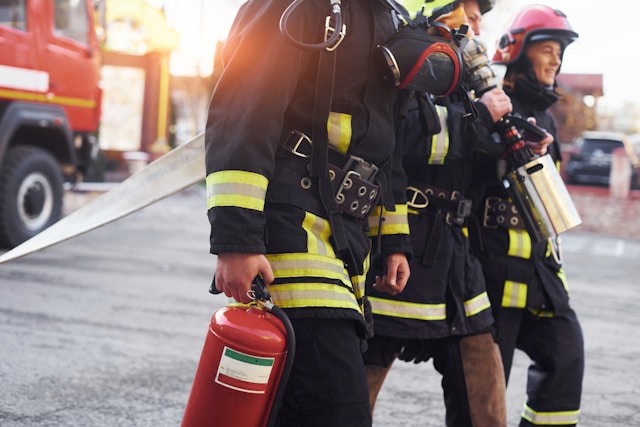Fire protection systems form a vital layer of defense in any building, and their importance grows as structures become more complex and densely occupied. These systems provide security that goes beyond compliance, safeguarding lives, maintaining business continuity, and protecting valuable assets. As modern environments evolve, fire risks change, making advanced protection essential. When organizations prioritize well-designed systems, they create safer spaces where people can live and work with confidence. This commitment to safety supports long-term stability and reinforces the value of thoughtful planning.

Advanced Detection That Responds Quickly
The foundation of a powerful fire protection system lies in how quickly and accurately it detects early warning signs. Modern sensors track smoke, temperature shifts, and airborne particles with impressive precision. They process multiple data points simultaneously, enabling them to distinguish between routine conditions and genuine threats. This reliability helps reduce unnecessary alarms and provides faster alerts when danger becomes real. Early detection gives everyone more time to react, which remains essential for reducing injury and preventing widespread damage. In buildings that rely on continuous activity, such as hospitals or manufacturing plants, this early response makes a significant difference.
Suppression Tools That Protect Without Disruption
Once a fire is identified, the next step is stopping it before it spreads. Today’s suppression systems are engineered to act quickly while minimizing harm to property. Water mist systems cool flames with remarkable efficiency, and clean-agent suppressants leave no residue, making them ideal for spaces that house electronics, documents, or specialized equipment. Hybrid solutions address multiple fire types in a single system, offering flexibility for diverse environments. Because these technologies operate automatically, they extinguish threats before they escalate, reducing downtime and lowering repair costs. Their precision helps organizations maintain smooth operations even in the face of unexpected emergencies.
Communication Systems That Support Immediate Action
Clear and dependable communication is essential when a fire occurs. Alarm and notification systems now combine audio announcements, visual signals, and mobile alerts to reach people quickly. As connected technologies grow, these systems deliver information to multiple recipients simultaneously, including building managers, emergency responders, and occupants. This coordinated communication shortens response times and guides people through critical decisions. When alerts arrive clearly and promptly, they help prevent confusion and allow everyone to focus on safe evacuation or proper action.
Advanced Evacuation Solutions for Safer Movement
Guiding people to safety remains a core function of any fire protection system. Today’s evacuation solutions integrate intelligent lighting, real-time hazard tracking, and route guidance that adjusts to changing conditions. These systems detect blocked corridors, heavy smoke, or structural issues and adapt evacuation paths to ensure faster, safer movement. This adaptability reduces panic, organizes foot traffic, and increases the chances of successful evacuation. As buildings become more complex, these intelligent tools provide clarity and direction when people need them most.
Maintenance That Ensures Reliability Over Time
Even the most advanced fire protection system must be maintained regularly to remain effective. Predictive monitoring tools now track performance and detect potential issues before they disrupt system function. Routine testing and inspections confirm that alarms, detectors, and suppression systems work precisely as intended. Proactive maintenance prevents system failures and protects investments by extending the lifespan of critical components. When organizations stay consistent with upkeep, they reinforce their commitment to safety and strengthen trust among employees, clients, and residents.
Smart Integration That Enhances System Performance
Technology integration has transformed fire protection into an interconnected ecosystem. Centralized control platforms enable managers to oversee all components simultaneously, improving visibility and decision-making during emergencies. AI-based tools analyze patterns, identify risks, and deliver insights that support more effective strategies. This level of integration ensures that detection, suppression, communication, and evacuation systems operate together seamlessly. As a result, responses become faster, wiser, and more coordinated, strengthening the overall safety profile of any building.
Sustainable Approaches for Modern Protection
Sustainability is increasingly shaping fire protection design. Water-efficient systems reduce waste, and environmentally friendly agents help protect both people and the planet. Manufacturers now focus on developing durable materials and recyclable components that support long-term environmental goals. These sustainable methods align with modern standards and demonstrate responsible building practices. At the same time, they ensure performance remains strong and reliable, enabling protection of resources without sacrificing safety.
High-performance fire protection systems rely on fast detection, effective suppression, strong communication, intelligent evacuation, and consistent maintenance. These components work together to create safer environments and support long-term resilience. With advancements in innovative technology and sustainable design, modern systems deliver greater accuracy, efficiency, and reliability than ever before. When organizations invest in comprehensive fire protection, they reinforce safety at every level and build spaces that remain secure, responsive, and well-prepared for emergencies.













